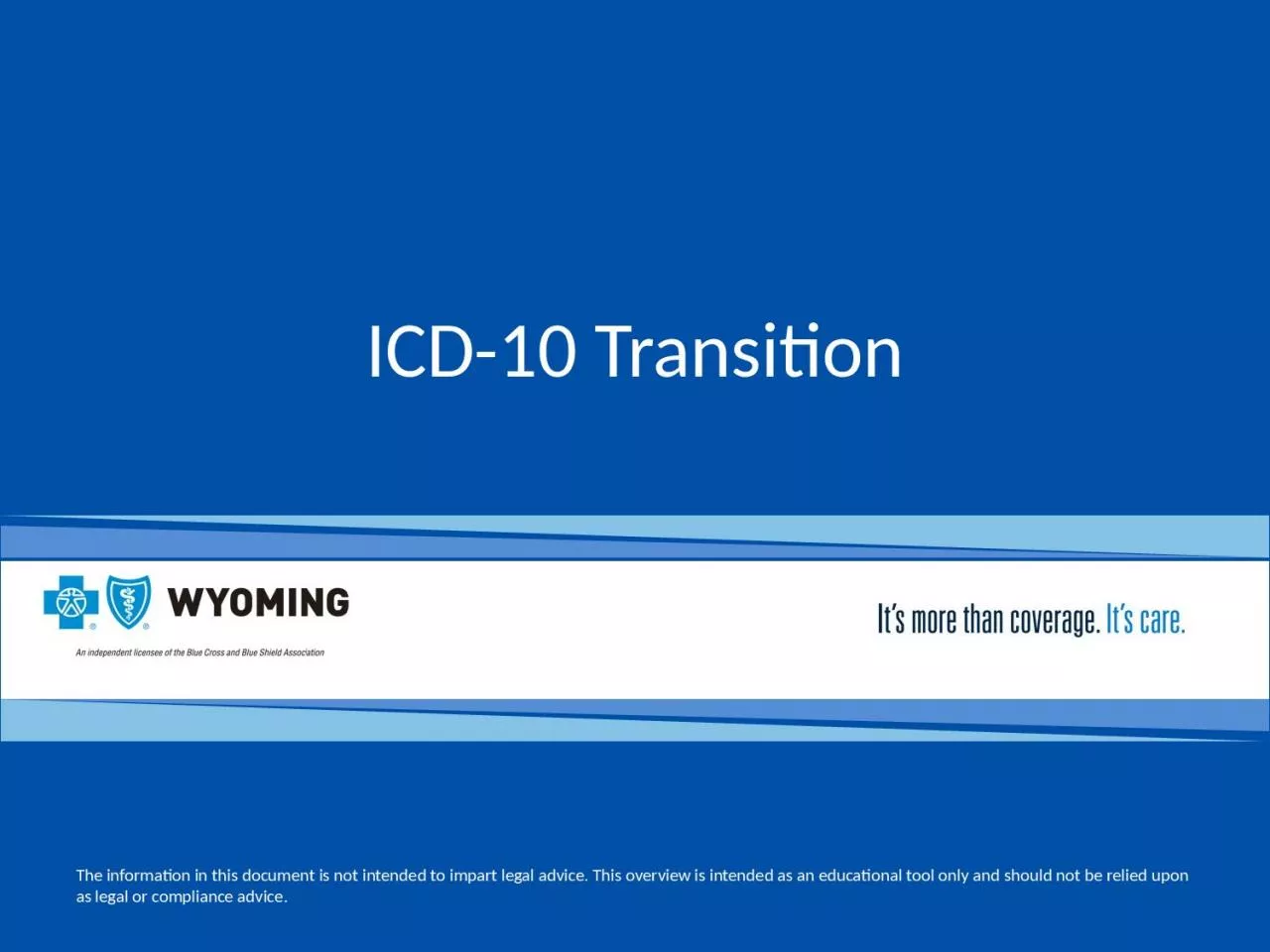

The ICD10 Mandate ICD10 implementation is scheduled for October 1 2014 For claims with this date of service forward all HIPAAcovered healthcare entities must begin using ICD10 codes in place of the ICD9 codes ID: 1035986
Download Presentation The PPT/PDF document "ICD-10 Transition The information in t..." is the property of its rightful owner. Permission is granted to download and print the materials on this web site for personal, non-commercial use only, and to display it on your personal computer provided you do not modify the materials and that you retain all copyright notices contained in the materials. By downloading content from our website, you accept the terms of this agreement.
1. ICD-10 Transition The information in this document is not intended to impart legal advice. This overview is intended as an educational tool only and should not be relied upon as legal or compliance advice.
2. The ICD-10 MandateICD-10 implementation is scheduled for October 1, 2014.For claims with this date of service forward, all HIPAA-covered healthcare entities must begin using ICD-10 codes in place of the ICD-9 codes. Delivered in two parts – ICD-10-CM (for all providers in all healthcare settings) and ICD-10-PCS (for hospital claims and inpatient hospital procedures).Does not affect CPT or HCPCS codes and usage.
3. Differences Between ICD-9 and ICD-10The code sets make ICD-10 look like an entirely different coding language. Code titles are more complete.Specificity and detail significantly expanded.Certain diseases reclassified to reflect current medical knowledge.Main differences include: Volume Structure New Features
4. Volume Differences About 150,000 ICD-10 codes will replace 17,000 ICD-9 codes.The greater level of detail in ICD-10 causes the increased volume.
5. Structural Differences – ICD-9-CM
6. Structural Differences – ICD-10-CM
7. ICD-10-CM New FeaturesCombination codes for some conditions and associated symptoms.Laterality Expansion of some codesInjuries DiabetesAlcohol and substance abusePost-op complicationsInjuries grouped by anatomical site instead of by category.
8. Appropriate CodingICD-10 is an example of appropriate coding.This is not up-coding.It’s about following national coding guidelines and making sure to accurately describe a patient’s condition.Some important notes about appropriate coding:Valid signatures are needed in medical records,Specificity in medical record notes is essential,Code claims with accurate level of specificity,Document and code all conditions (i.e. Stage 2 CKD, ESRD, Major Depression)
9. Appropriate CodingEnsures appropriate benefit application and/or payment (if applicable). Helps to reduce the possibility of requests for medical records.May help reduce the instances of medical record reviews.
10. Different Views of ICD-10Clinician Perspective: ICD-10 is understanding the increased level of detail needed in the medical record documentation. Coder Perspective: Training is required to understand the additional detail in the codes. BCBSWY Perspective: Make sure that our systems can accept the submitted codes and pay claims/ apply benefits appropriately.
11. Important Points From an Industry PerspectiveICD-10 most likely will increase the need for certified coders due to the increased detail in the code set. Entities must take into consideration external factors (such as impacts of Health Care Reform and requirements of Medicare and Medicaid) when planning for ICD-10.A maintenance process must be in place as part of a long-term solution to enable processing of codes.How do you update the codes today?With increased volume, that process may need to change.
12. Medical Records – Increased DetailBecause of ICD-10 specificity, provider documentation must change to meet the new level of detail. For example…Diagnosis:Obesity must be specified in ICD-10 if due to excess calories or if drug induced. Angina Pectoris is further classified as unstable angina, angina pectoris with documented spasm or other forms of angina pectoris. Asthma is specified as mild intermittent, mild persistent, moderate persistent and severe persistent. Tobacco dependence in ICD-9 becomes Nicotine dependence in ICD-10. The type of nicotine dependence must be documented for coding purposes. Procedures:Transfusion of Packed Red Blood Cells need to specify if red blood cells are fresh or frozen. Hernia repairs require the device (graft/implant) to be coded to autologous tissue substitute, synthetic substitute or nonautologous tissue substitute. Radiological procedures (aortogram, arteriography performed under fluoroscopy) need to specify contrast material used (High Osmolar, Low Osmolar or other contrast)
13. Next steps to prepare for ICD-10*Determine ImpactIdentify training needsReach out to othersLearn about the ICD-10 code setIdentify all places within your organization that use ICD-9 codes and understand the impact of the transitionDetermine strengths and weaknesses in medical record documentation Staff review and refresh medical terminologyPlan for coder training (6-9 months prior to implementation) Talk to business partners about ICD-10 readiness (payers, vendors, billing services, etc.) Be sure to discuss testing capabilities *Information from CMS’ MLN Matters, SE1019
14. ICD-10 ReadinessStart recoding the superbill and determine the documentation required to code accurately.Manifestations now included in chapter, but some will need an additional code.Do you need to expand the superbill based on physician activities? CMS General Equivalence Mappings (GEMs)Provide code to code translation.Where else are ICD-9 codes used in your practice? Training: coding classes, refresher on medical terminology (many terms have been updated in ICD-10), and anatomy and physiology
15. BCBSWY Transition Plan Transition plan in place since early 2011. Will be ready to accept and process claims with ICD-10 on October 1, 2014. Will communicate with participating providers at appropriate stages.